On 28 December 2016, about 90 days before its 25th anniversary, the RIPE NCC reached the milestone of serving 15,000 active Local Internet Registries (LIRs). In this article we look at trends observed in the membership in the last few years. We also assess the remaining lifetime of the last bit of IPv4 in our available pool.
The growth in LIRs has been accelerating over the past years. The RIPE NCC started operations in April 1992. By September that year, 36 Local Internet Registries had been identified and set-up. 15 years later, in June 2007, we reached the 5,000 LIRs milestone. The 10,000 mark was reached just seven years later on 18 February 2014. And now, with less than three years since that last milestone, the number of LIRs has reached 15,000.
Figure 1 shows in more detail how the number of LIRs has evolved over time. In the late 1990s growth was also exponential. The Internet had started to go mainstream and the industry was booming. Net growth came to a halt in the year 2000, when the dotcom bubble burst and many LIRs closed. In 2002 it picked up again and was stable for the next ten years. Following the exhaustion of IPv4, and the RIPE NCC reaching its last /8 on 14 September 2012, we see growth accelerating again.
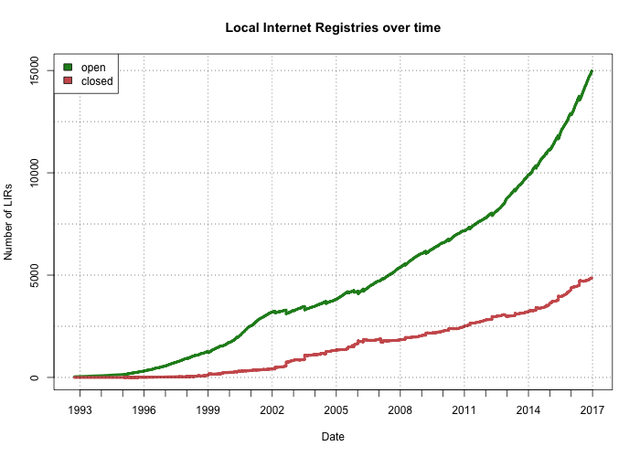
Figure 1: Number of LIRs over time
The actual rate at which new LIRs are established is even higher than Figure 1 suggests. Because part of the existing LIRs close as time goes by (due to merger, acquisition or in recent years consolidation of multiple accounts), the green line shows the net growth: newly opened minus recently closed LIRs.
Figure 2 takes a closer look at the rate that LIRs join. For each quarter the bars show how many LIRs signed the service agreement in the respective period. The colours within the bars indicate present status: the number of active, open LIRs is represented by the yellow part, the number of closed LIRs is in red. A relatively small number of LIRs are "Pending Closure". These LIRs had their service agreement cancelled, most often because of non-payment of membership fees. While the administrative aspects of the closure are in progress, the status of these LIRs is set to pending closure rather than closed. In this phase, the affected organisation still has the option to reopen the account and keep the allocated resources, provided all outstanding invoices are paid along with a new sign-up fee.
The bar chart shows how in the last quarter of 2016, the number of newly-established LIRs remains high; with a few more days to go, it is on the same level as in the first and second quarter of 2016. The chart also shows that only a small percentage of the LIRs that joined in 2016 have closed by now. For 2015 it is substantially higher. But overall, the majority of LIRs which were established in the last 14 years, from January 2003 on, are still active.
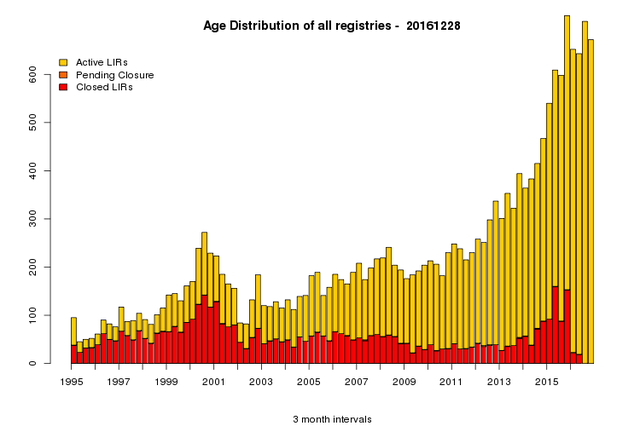
Figure 2: Distribution of LIR activation dates and present status.
Figure 3 shows the age distribution of the active LIRs from different angles. Instead of grouping by sign-up date, Figure 3a groups the LIRs by the amount of time elapsed since sign-up. This most clearly shows how the LIRs which were activated in the last 12 months form the largest group: more than 2,500 of them. With some exceptions (notably around the dotcom-bubble 16-18 years ago), the general tendency is to have fewer active LIRs the older they get. Because there were fewer to start with, but also because a larger percentage by now have closed; more time has passed for them to merge with or be acquired by other organisations or discontinue business altogether.
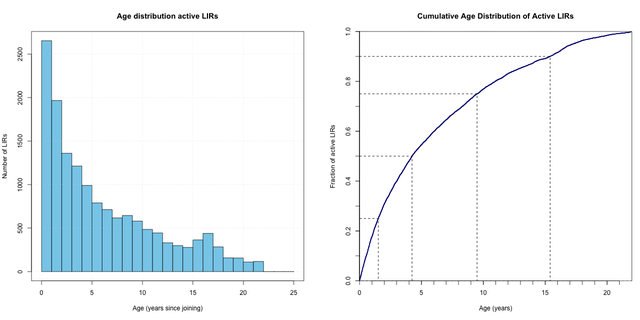
Figure 3a and 3b: Age distribution of currently-active LIRs
In Figure 3b we look at the cumulative age distribution, showing what fraction of the total number of active LIRs is younger than a given age. This highlights best how the RIPE NCC membership is dominated by relatively young LIRs. 50% of the presently active registries joined within the last 4.25 years, i.e. after 25 September 2012, after RIPE NCC's IPv4 pool reached the last /8 and allocation policies switched to the mode of one final /22 per LIR. This shows that even in this exhaustion phase, IPv4 is in high demand; organisations primarily join the RIPE NCC and open additional accounts to get a small part of the remaining addresses. Figure 4, which looks at the status of LIRs with respect to the final allocation they are entitled to, confirms this. The overwhelming majority of new LIRs, activated after 14 September 2012, have received their final /22. For older LIRs this is more balanced. 27.1% out of the 49.8% which fall into this category have yet to request the last 1,024 IPv4 addresses they can get from the RIPE NCC.
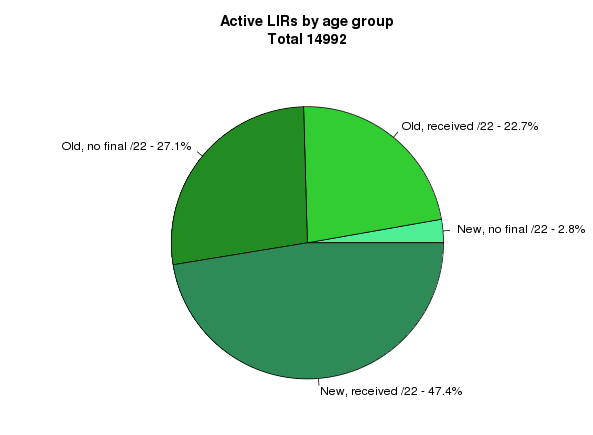
Figure 4: Distribution of active LIRs by age group and status of final /22 allocation
Country distributions
In Figure 5, we look at the changes in the distribution of LIRs over the countries they are registered in. Figure 5a on the left shows the status on 18 February 2014, when we reached the 10,000 LIRs milestone. At that time the United Kingdom was leading with 11.7% of the LIRs registered there, vs. 11.2% in the Russian Federation which came in second place. Figure 5b on the right shows the distribution of countries for those LIRs that were activated after reaching the 10,000 LIR mark and are still active today. The United Kingdom takes a similar slice as in the first pie. Germany is 1% lower and Russia almost halved from 11.2% of all Feburary 2014 LIRs to just 6.4% of those who joined later. As a consequence, the Russian Federation has now dropped to third place in contributing countries, with 9.0% of the LIRs coming from that country. Spain, Poland, the Netherlands, France, Iran and the USA all see their share increasing.
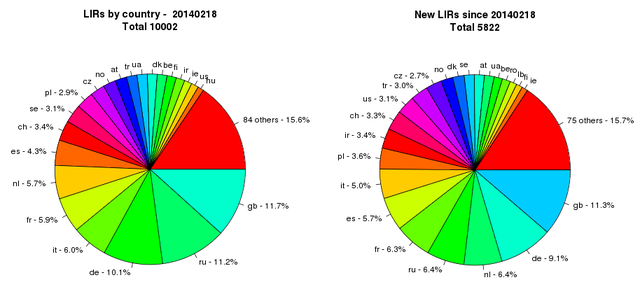
Figure 5: Distribution of countries where LIRs are registered. Status of February 2014 (left) and distribution for LIRs who joined since (right).
Estimated lifetime of remaining IPv4
As discussed in our previous article on RIPE NCC membership statistics, the rate at which new LIRs are established is an important factor in estimating when the RIPE NCC IPv4 pool will be fully depleted. Since the IPv4 policy entitles each LIR to request one final /22 and we currently have around 4,500 LIRs (of all ages) who have yet to request their /22, the 13 million IPv4 addresses currently left in the available pool can not all be taken by the existing LIRs. Figure 6a below shows the growth in allocations from 185/8 as a function of time; for all LIRs, but also for the old LIRs who were established before the RIPE NCC reached the last /8 and the new ones who were established after. To first approximation, the last two years are well described by linear growth. The thin blue line represents the best fit, at 9,000 allocated IPv4 addresses per day.
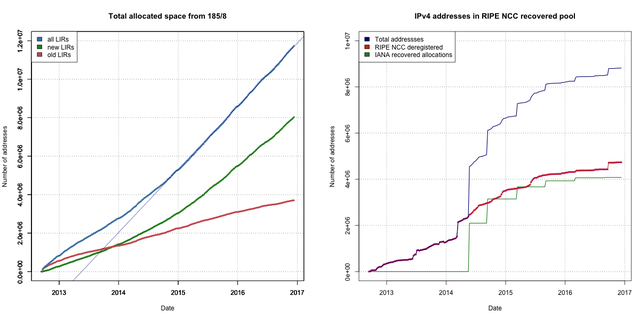
Figure 6: Evolution of allocations from 185/8 (left) and the RIPE NCC recovered pool since 14 September 2012
The other factor, IP addresses coming back to the RIPE NCC from IANA's recovered pool and from deregistration of resources held by LIRs when they close, is losing significance. The IANA pool has almost dried up. The allocation round from September 2016 saw the equivalent of a /18 come our way, enough to fullfill 16 /22 allocations. And on the deregistration side the only significant contribution, about 280,000 addresses, came from the closure of a single LIR.
If no more IPv4 space is recovered and linear growth prevails, the present 13.2 million addresses in the available pool would last until the beginning of 2021. With occasional reclaims and deregistrations of the size we saw in October 2016, the lifetime could be expanded for some more months, which would make RIPE NCC run out in the middle of 2021.
Conclusion
In recent years LIRs have been established at the RIPE NCC in ever increasing rates. The milestone of 15,000 LIRs was reached less than three years after passing the 10,000th LIR mark. The main reason for this is the general shortage of IPv4 addresses. Organisations that might have chosen to obtain IP addresses assignments either directly from their service provider's allocation or via a sponsoring LIR before the RIPE NCC reached its exhaustion phase now have to get IPv4 from the transfer market or join the RIPE NCC as an LIR to get their first and only /22 allocation. At the present rate, and with present policies, the remaining IPv4 space at the RIPE NCC is expected to last another four to five years and will likely take us across the 20,000 active LIRs mark.


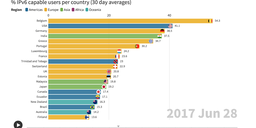
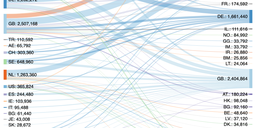

Comments 2
Comments are disabled on articles published more than a year ago. If you'd like to inform us of any issues, please reach out to us via the contact form here.
Hugh Collins •
"If no more IPv4 space is recovered and linear growth prevails, the present 13.2 million addresses in the available pool would last until the beginning of 2017." This does not look right - should the date at the end be 2021? Best Regards.
Alun Davies •
Thanks! We spotted that just now and it's been changed from 2017 to 2021 as you pointed out.